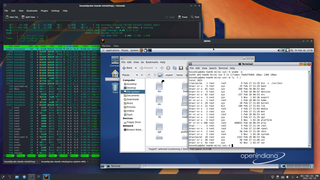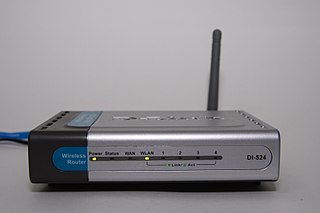Related Research Articles
Internet Small Computer Systems Interface or iSCSI is an Internet Protocol-based storage networking standard for linking data storage facilities. iSCSI provides block-level access to storage devices by carrying SCSI commands over a TCP/IP network. iSCSI facilitates data transfers over intranets and to manage storage over long distances. It can be used to transmit data over local area networks (LANs), wide area networks (WANs), or the Internet and can enable location-independent data storage and retrieval.

Network-attached storage (NAS) is a file-level computer data storage server connected to a computer network providing data access to a heterogeneous group of clients. The term "NAS" can refer to both the technology and systems involved, or a specialized device built for such functionality.
A disk array controller is a device that manages the physical disk drives and presents them to the computer as logical units. It almost always implements hardware RAID, thus it is sometimes referred to as RAID controller. It also often provides additional disk cache.
Operating systems based on the Linux kernel are used in embedded systems such as consumer electronics.

The Linksys WRT54G Wi-Fi series is a series of Wi-Fi–capable residential gateways marketed by Linksys, a subsidiary of Cisco from 2003 until acquired by Belkin in 2013. A residential gateway connects a local area network to a wide area network.
Netgear, Inc. is an American computer networking company based in San Jose, California, with offices in about 22 other countries. It produces networking hardware for consumers, businesses, and service providers. The company operates in three business segments: retail, commercial, and as a service provider.

QEMU is a free and open-source emulator. It emulates the machine's processor through dynamic binary translation and provides a set of different hardware and device models for the machine, enabling it to run a variety of guest operating systems. It can interoperate with Kernel-based Virtual Machine (KVM) to run virtual machines at near-native speed. QEMU can also do emulation for user-level processes, allowing applications compiled for one architecture to run on another.

A wireless router is a device that performs the functions of a router and also includes the functions of a wireless access point. It is used to provide access to the Internet or a private computer network. Depending on the manufacturer and model, it can function in a wired local area network, in a wireless-only LAN, or in a mixed wired and wireless network.
ATA over Ethernet (AoE) is a network protocol developed by the Brantley Coile Company, designed for simple, high-performance access of block storage devices over Ethernet networks. It is used to build storage area networks (SANs) with low-cost, standard technologies.
In Linux systems, initrd is a scheme for loading a temporary root file system into memory, to be used as part of the Linux startup process. initrd and initramfs refer to two different methods of achieving this. Both are commonly used to make preparations before the real root file system can be mounted.
The NSLU2 is a network-attached storage (NAS) device made by Linksys introduced in 2004 and discontinued in 2008. It makes USB flash memory and hard disks accessible over a network using the SMB protocol. It was superseded mainly by the NAS200 and in another sense by the WRT600N and WRT300N/350N which both combine a Wi-Fi router with a storage link.

Das U-Boot is an open-source, primary boot loader used in embedded devices to package the instructions to boot the device's operating system kernel. It is available for a number of computer architectures, including 68k, ARM, Blackfin, MicroBlaze, MIPS, Nios, SuperH, PPC, RISC-V and x86.

Target Disk Mode is a boot mode unique to Macintosh computers.
Ceph is an open-source software-defined storage platform that implements object storage on a single distributed computer cluster and provides 3-in-1 interfaces for object-, block- and file-level storage. Ceph aims primarily for completely distributed operation without a single point of failure, scalability to the exabyte level, and to be freely available. Since version 12, Ceph does not rely on other filesystems and can directly manage HDDs and SSDs with its own storage backend BlueStore and can completely self reliantly expose a POSIX filesystem.
Z-SAN is a proprietary type of storage area network licensed by Zetera corporation. Z-SAN hardware is bundled with a modified version of SAN-FS, which is a shared disk file system driver and management software product SAN File System (SFS) made by DataPlow. The shared disk file system allows multiple computers to access the same volume at block level. Zetera calls their version of the file system Z-SAN.

On Linux, network block device (NBD) is a network protocol that can be used to forward a block device from one machine to a second machine. As an example, a local machine can access a hard disk drive that is attached to another computer.
ElephantDrive is a storage virtualization service used primarily as an online backup tool, but also as a remote access service/collaboration tool. The service runs on Windows, Mac, Linux, iOS, and Android platforms, and allows users to create simple automated backups for protecting data by moving it into cloud-based ElephantDrive account.
In Unix-like operating systems, a device file or special file is an interface to a device driver that appears in a file system as if it were an ordinary file. There are also special files in DOS, OS/2, and Windows. These special files allow an application program to interact with a device by using its device driver via standard input/output system calls. Using standard system calls simplifies many programming tasks, and leads to consistent user-space I/O mechanisms regardless of device features and functions.

A storage area network (SAN) or storage network is a computer network which provides access to consolidated, block-level data storage. SANs are primarily used to access data storage devices, such as disk arrays and tape libraries from servers so that the devices appear to the operating system as direct-attached storage. A SAN typically is a dedicated network of storage devices not accessible through the local area network (LAN).

The SheevaPlug is a "plug computer" designed to allow standard computing features in as small a space as possible.
References
- ↑ "Netgear SC101". Archived from the original on March 4, 2009. Retrieved May 24, 2013.
- 1 2 "Netgear SC101T". Archived from the original on March 6, 2009. Retrieved May 24, 2013.
- ↑ "Zetera's Z-SAN(TM) technology receives acclaim as it comes to market in NETGEAR(R) product". SAN/LAN Newsletter. Vol. 23, no. 9. Information Gatekeepers. September 2005. pp. 11–12.
- ↑ "Netgear SC101 Storage Central Review". CNET. October 17, 2005. Retrieved May 24, 2013.
- ↑ "Review: NETGEAR SC101 Storage Central". Tom's Hardware. October 11, 2005. Archived from the original on March 29, 2012. Retrieved May 24, 2013.
- ↑ Andrew Tan (January 2006). "Digital Piggy Bank". HWM. p. 84. Retrieved May 24, 2013.
- ↑ "Netgear storage systems". Archived from the original on January 14, 2010. Retrieved May 24, 2013.
- ↑ "SC101 Mount Partition in Linux - NETGEAR Forums" . September 30, 2008. Retrieved May 24, 2013.
- ↑ "sc101-nbd - Google Code" . Retrieved May 24, 2013.
- ↑ "Zetera Z-San Filesystem and Devices - Any Linux Interest?". KernelTrap. July 6, 2006. Archived from the original on July 19, 2006. Retrieved May 24, 2013.